This pub is closed permanently. Your nearest Wetherspoon pub: The Moon Under Water
The famous writer George Orwell described his ideal pub – ‘Moon Under Water’. It is why the word ‘moon’ is used in the name of several Wetherspoon pubs. This pub occupies the former banking hall of Cocks, Biddulph & Company. Established on this site in 1757, the present building was completed in 1873. The prestigious bank eventually became a branch of Barclays, trading here until 1992.
Framed drawings and text about Whitehall in the 15th century.
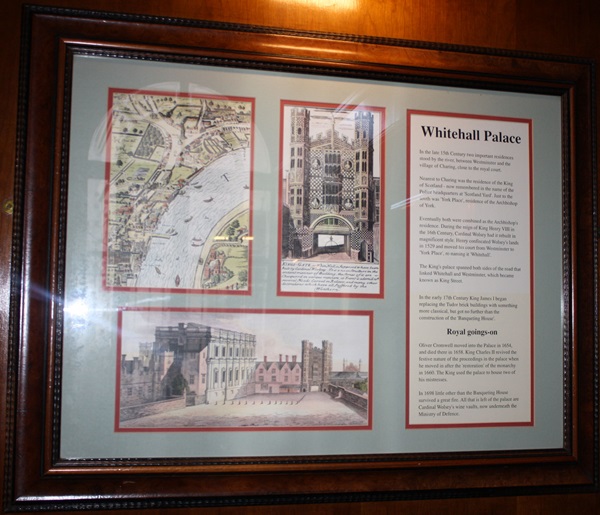
The text reads: In the late 15th century two important residences stood by the river, between Westminster and the village of Charing, close to the royal court.
Nearest to Charing was the residence of the King of Scotland –now remembered in the name of the Police headquarters at ‘Scotland Yard’. Just to the south was ‘York Place’, residence of the Archbishop of York.
Eventually both were combined as the Archbishop’s residence. During the reign of King Henry VIII in the 16th century, Cardinal Wolsey’s lands in 1529 and moved his court from Westminster to ‘York Place’, re-naming it ‘Whitehall’.
The King’s place spanned both sides of the road that linked Whitehall and Westminster, which became known as King Street.
In the early 17th Century King James I began replacing the Tudor brick buildings with something more classical, but got no further than the construction of the ‘Banqueting House’
Oliver Cromwell moved into the Palace in 1654, and died there in 1658. King Charles II revived the festive nature of the proceedings in the palace when he moved in after the ‘restoration’ of the monarchy in 1660. The King used the palace to house two of his mistresses.
In 1968 little other than the Banqueting House survived a great fire. All that is left of the palace are Cardinal Wolsey’s wine vaults, now underneath the Ministry of Defence.
Framed drawings and text about Big Ben.
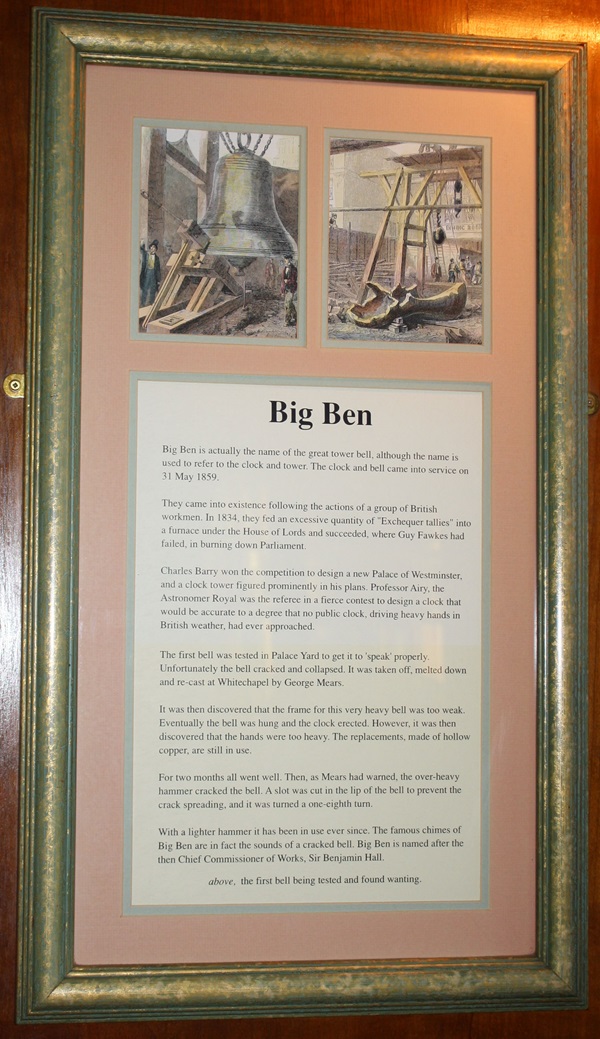
The text reads: Big Ben is actually the name of the great tower bell, although the name is used to refer to the clock and the tower. The clock and bell came into service on 31 May 1859.
They came into existence following the actions of a group of British workmen. In 1834, they fed an excessive quantity of ‘Exchequer tallies’ into a furnace under the House of Lords and succeeded, where Guy Fawkes had failed, in burning down Parliament.
Charles Barry won the competition to design a new Palace of Westminster, and a clock tower figured prominently in his plans. Professor Airy, the Astronomer Royal was the referee in a fierce contest to design a clock that would be accurate to a degree that no public clock, driving heavy hands in British weather, had ever approached.
The first bell was tested in Palace Yard to get it to ‘speak’ properly. Unfortunately the bell cracked and collapsed. It was taken off, melted down and re-cast at Whitechapel by George Mears.
It was then discovered that the frame for this very heavy bell was too weak. Eventually the bell was hung and the clock erected. However, it was then discovered that the hands were too heavy. The replacements, made of hollow copper, are still in use.
For two months all went well. Then as Mears had warned, the over-heavy hammer cracked the bell. A slot was cut in the lip of the bell to prevent the crack spreading, and it was turned a one- eighth turn.
With a lighter hammer it has been in use ever since. The famous chimes of Big Ben are in fact the sounds of a cracked bell. Big Ben is names after the Chief Commissioner of works, Sir Benjamin Hall.
A framed drawing and text about Trafalgar Square.

The text reads: In 1830, this world-famous square almost began its life as King William IV Square. However, an architect, George Ledwell Taylor, had other ideas and approached the King with a proposal to name the square after Lord Nelson, the hero of the Battle of Trafalgar.
Taylor had an audience with the King. “I had some difficulty opening my case, but His Majesty took kindly to my arguments and said – I like the idea, let it be called Trafalgar Square”.
The site had previously been the Royal Mews. Where the National Gallery now stands was once the Royal Stables. The new square was designed by John Nash as part of a scheme to link up Whitehall with the British Museum in Bloomsbury. After the square had been named, a competition was held to design a monument to Lord Nelson.
In 1839 two competitions were held. After the first, the organisers- ‘The Nelson Memorial Committee’ – sent all the entrants off to try again. In the Re-run William Railton’s design was chosen.
The decision was received with an almost universal lack of enthusiasm. By common consent the pillar “broke the line” of the National Gallery building but it seems few people liked that building either. After all, as one critic pointed out, it had always been Nelson’s practice to break the enemy’s line.
Charles Barry, who was responsible for the layout of the square, was also against the Column. A select Committee reported to Parliament that the column was ‘undesirable’ but, the House of Commons allowed work to begin.
It took from 1840 until 1867 to erect the column and set Sir Edwin Landseer’s four lions around the base. One magazine referred to it at the time as “this monstrous nine-pin”.
A framed drawing and text about The Banqueting House.

The text reads: The Banqueting House is the last remaining part of the old Palace of Whitehall, having survived the fire of 1698. Work began in 1619 on this building designed by Inigo Jones for King James I.
At that time the other Whitehall buildings were brick and timber affairs. Inigo Jones’ Palladian style masterpiece was, along with his Queens House at Greenwich, one of the first classical buildings in England.
Underneath the Hall, in the basement, James I maintained an ‘exclusive nightclub’ for himself and a select few - mainly handsome young men such as George Villiers, the Duke of Buckingham.
The ceiling in the Hall was painted by Peter Paul Rubens for Charles I in memory of his father James I. Rubens painted the canvasses in his studio in Antwerp, installing them in the great Hall in 1635.
The Banqueting House was used for court masques (entertainments combining verse, drama and song) and also for state occasions. The last masque was performed here in 1635.
In 1649, after spending his last night at St James Palace, King Charles I was led through one of the great windows in the Hall onto a scaffold and beheaded. In 1660 the diarist Samuel Pepys watched the roof of the Banqueting House as King Charles II paraded in triumph along Whitehall after his ‘restoration’ to the throne.
The building was used as the Chapel Royal until 1890, when Queen Victoria granted it as a museum to the Royal United Service Institution. This impressive classical building is now open to the public.
Framed drawings and text about St James’ Park.

The text reads: St James’ Park was originally marshland. In the 16th Century King Henry VIII had it drained, enclosed within a wall, and made it into a deer park.
However, his daughter Elizabeth I neglected it. When King James I succeed her in 1603, the park was an unsightly mess in front of his palace at Whitehall.
James had the park cleared and, although he was as keen a huntsman as his predecessors, decided to turn the park into a wild life sanctuary.
His menagerie included an elephant, crocodiles, camels, flying squirrels and a leopard. During the winter the King insisted his elephant had a gallon of wine every morning.
St James Park was later turned into an ornamental garden in the ‘French manner’ by King Charles II, where the King enjoyed feeding the ducks and walking his dogs.
The plantation and walks that we see today were designed by John Nash for King George IV.
Framed photographs of Trafalgar Square c1920.
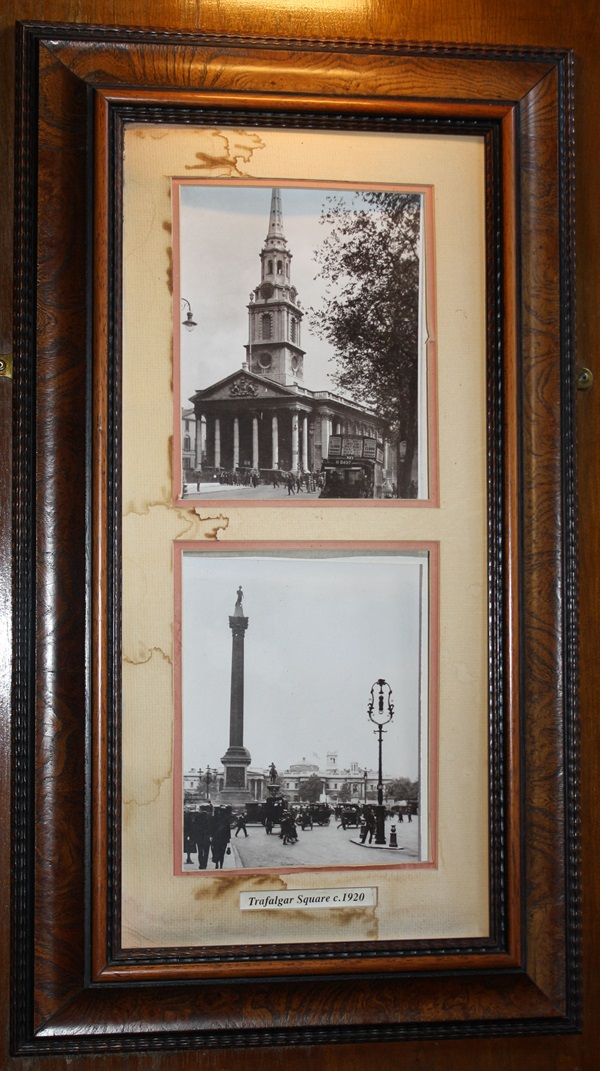
A framed painting of Whitehall stairs from the river.

A framed photograph of Whitehall, c1905.
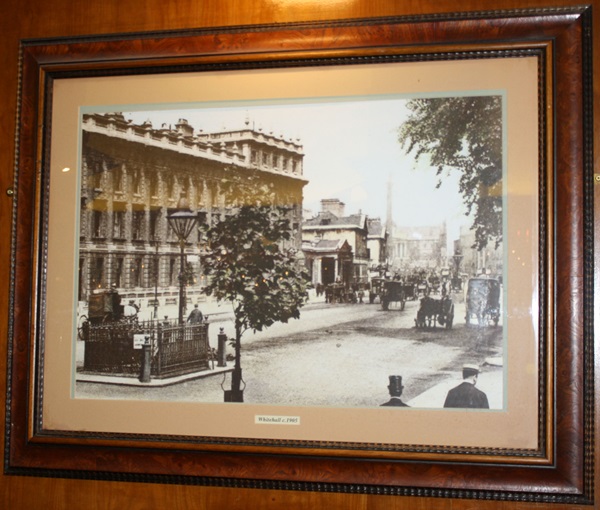
A framed drawing of part of Whitehall to the Thames.
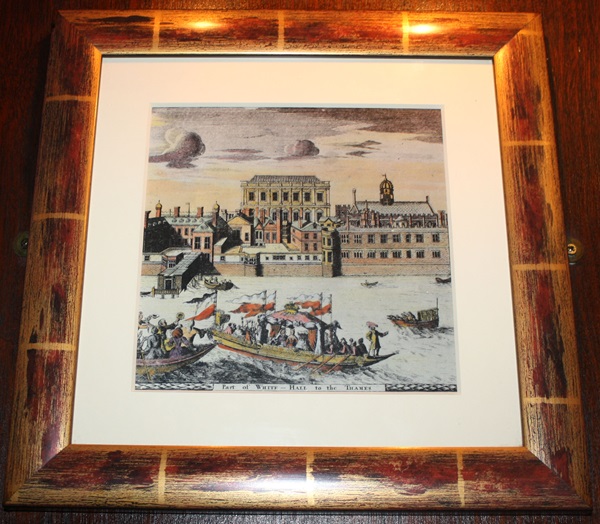
Framed drawings of Whitehall and The Banqueting Hall (from bottom to top) 1669, 1713 and 1753.

An archaic statue of a woman, present in the middle of the building.

A photograph of the main entrance. The design incorporates the previous use of the building as a bank.
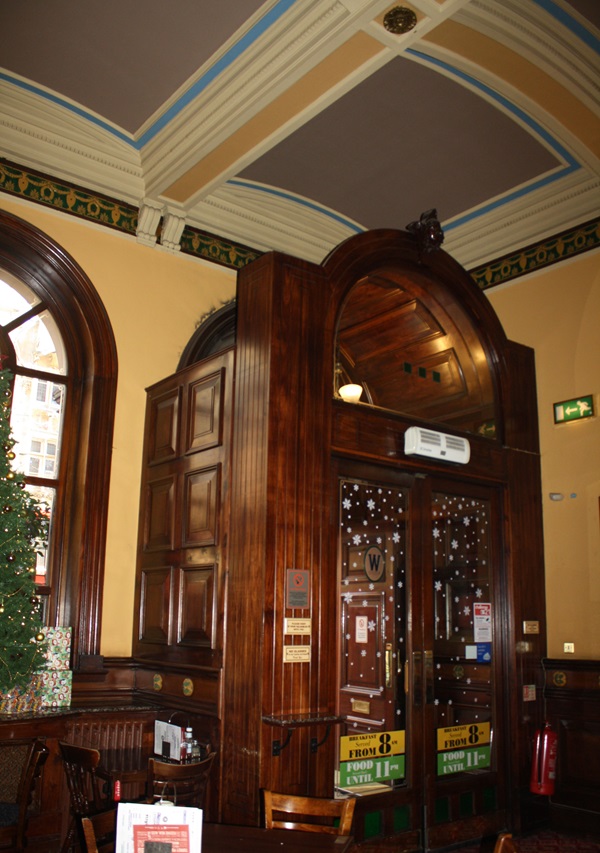
External photograph of the building – front.
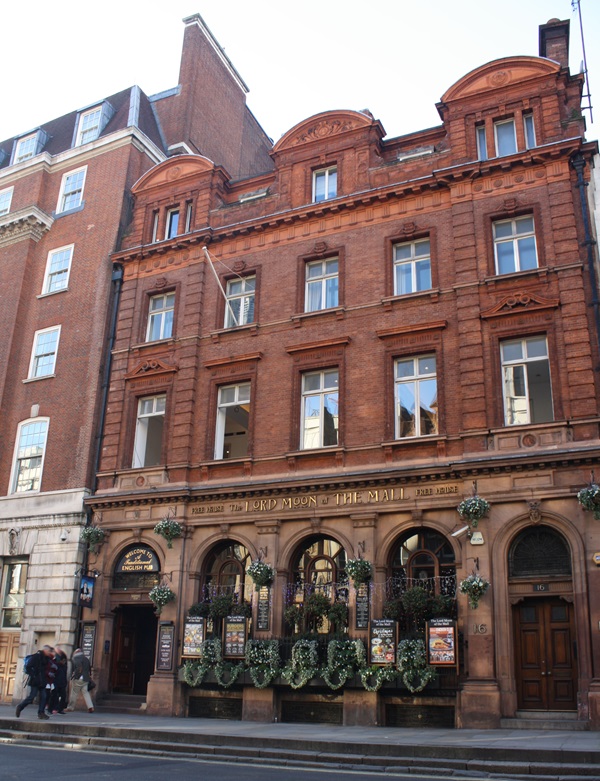
If you have information on the history of this pub, then we’d like you to share it with us. Please e-mail all information to: pubhistories@jdwetherspoon.co.uk